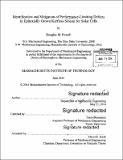| dc.contributor.advisor | Tonio Buonassisi. | en_US |
| dc.contributor.author | Powell, Douglas M. (Douglas Michael) | en_US |
| dc.contributor.other | Massachusetts Institute of Technology. Department of Mechanical Engineering. | en_US |
| dc.date.accessioned | 2014-12-08T18:54:17Z | |
| dc.date.available | 2014-12-08T18:54:17Z | |
| dc.date.copyright | 2014 | en_US |
| dc.date.issued | 2014 | en_US |
| dc.identifier.uri | http://hdl.handle.net/1721.1/92172 | |
| dc.description | Thesis: Ph. D., Massachusetts Institute of Technology, Department of Mechanical Engineering, 2014. | en_US |
| dc.description | Cataloged from PDF version of thesis. | en_US |
| dc.description | Includes bibliographical references (pages 116-125). | en_US |
| dc.description.abstract | Reducing material use is a major driver for cost reduction of crystalline silicon photovoltaic modules. The dominant wafer fabrication process employed in the industry today, ingot casting & sawing, wastes approximately half of the input silicon feedstock due to sawdust (kerf) and ingot tailings. Alternative "kerfless" wafer-fabrication technologies avoid ingot casting and sawing, and can reduce the amount of silicon feedstock used by over 5x. But for kerfless silicon to be cost effective, wafers must be of high electrical quality, as the power conversion efficiency of a photovoltaic module is the strongest determinant of manufacturing cost. Epitaxially grown kerfless silicon has the potential to both significantly reduce silicon waste, and provide sufficient electrical quality to support high-efficiency photovoltaic modules because of its single-crystal structure and low structural defect density. The goals of this research effort are to identify the root cause of underperformance of epitaxial wafers, to develop defect-mitigation strategies, and to translate these to electronic performance improvements. Low carrier lifetimes, a measure for electrical performance, of < 1 is were observed in as-grown epitaxial material. Injection level dependent lifetime, bulk mass spectrometry (ICP-MS), deep level transient spectrometry (DLTS), and micro x-ray fluorescence ([mu]-XRF) measurements were completed to identify underlying performance-limiting defects. The comparison of the defect concentrations obtained in the above measurements to Shockley-Read-Hall (SRH) recombination modeling indicates that a getterable impurity contaminant is the primary performance limiting defect in p-type as-grown material. The gettering response of p-type epitaxial material is assessed for two generations of wafer growth equipment. In the first generation of material, gettered lifetimes were < 20 [mu]s at an injection level of 10¹⁵ cm-³ . While a significant improvement over as-grown performance, this performance level is inadequate for high-efficiency photovoltaics. A second generation of material was grown in an upgraded environment with improved impurity management and greater automation. The effective lifetime of the second generation of material improved over lOx. With the application of standard and extended phosphorus diffusion gettering processes, effective lifetimes of over 300 [mu]s and estimated bulk lifetimes over 800 [mu]s are achieved in < 100 pm thick p-type epitaxial wafers at an injection level of 10¹⁵ cm-³ with highly effective Al₂O₃ surface passivation. Very low concentrations of interstitial iron, a dominant defect in p-type c-Si, were achieved after standard (2.5 +/- 0.76)x10¹⁰ cm-³ and extended (3.2 +/- 7.4)x10⁹ cm-³ gettering processes. With bulk mass spectrometry and SRH recombination modeling, the source for the lifetime change between generations is identified as a reduction in contamination of difficult to getter impurities including Mo and V. Other potential performance limiting defects, including interstitial iron contamination and structural defect density, are not observed to change between generations. Both the excellent gettering response and low as-grown lifetime of the material is attributed to the rapid cooling and low density of heterogeneous nucleation sites in as-grown material. This leads to a large concentration of point-defects, a more recombination active configuration than precipitates, in as-grown material. Controlled pre-gettering annealing experiments of as-grown material showed that material performance after gettering can be reduced with pre-gettering annealing. Similarly, as-grown and gettered material was assessed for n-type epitaxial wafers. As-grown lifetime is again low, < 1 [mu]s, but improves to over 800 [mu]s (effective) at an injection level of 10¹⁵ cm-³. In the as-grown state, a getterable impurity is indicated to limit lifetime. The effective lifetime of over 800 [mu]s at an injection level of 10¹⁵ cm-³ of the n-type material results in a calculated surface passivation effectiveness that matches the best results obtained with Al₂O₃ This indicates that no unintended contaminant is responsible for the performance of the wafer. In conclusion, very high effective lifetimes, eclipsing values achieved with historic kerfless silicon growth technologies, are demonstrated with epitaxial kerfless silicon for solar cells after gettering. The achieved lifetimes are capable of supporting high-efficiency device architecture. Using defect science, the underlying causes for underperformance of as-grown material and early generations of growth are indicated. | en_US |
| dc.description.statementofresponsibility | by Douglas M. Powell. | en_US |
| dc.format.extent | 136 pages | en_US |
| dc.language.iso | eng | en_US |
| dc.publisher | Massachusetts Institute of Technology | en_US |
| dc.rights | M.I.T. theses are protected by copyright. They may be viewed from this source for any purpose, but reproduction or distribution in any format is prohibited without written permission. See provided URL for inquiries about permission. | en_US |
| dc.rights.uri | http://dspace.mit.edu/handle/1721.1/7582 | en_US |
| dc.subject | Mechanical Engineering. | en_US |
| dc.title | Identification and mitigation of performance-limiting defects in epitaxially grown kerfless silicon for solar cells | en_US |
| dc.type | Thesis | en_US |
| dc.description.degree | Ph. D. | en_US |
| dc.contributor.department | Massachusetts Institute of Technology. Department of Mechanical Engineering | |
| dc.identifier.oclc | 897205155 | en_US |
